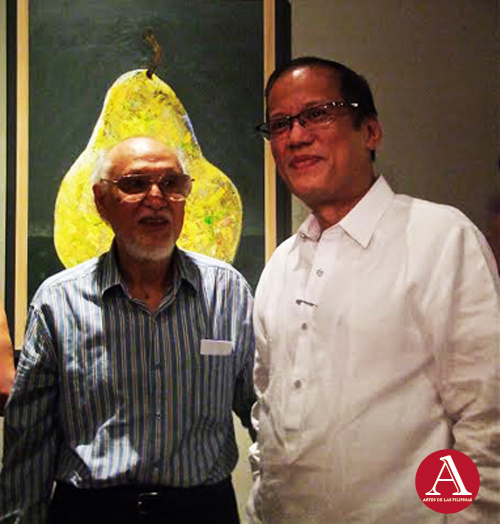
With President Noynoy Aquino in an art exhibit at Casa Roces
Alfredo Roces: Man of Arts and Letters (Second of Two Parts)
by: Christiane L. de la Paz
Have you ever exhibited your pottery or other works in Sydney?
I have exhibited at the Watercolor Institute and other group shows. I had a one man show at the Philippine Consulate. Recently with three other FIlipinos artists we exhibited at the Arthouse in downtown Sydney.
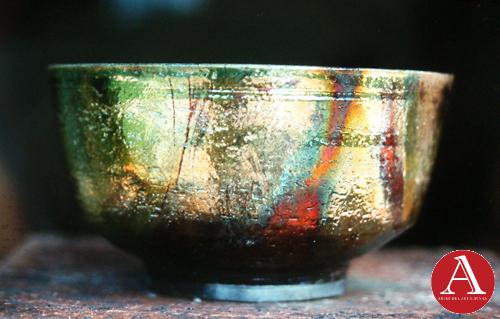
Raku fired pottery (1982)
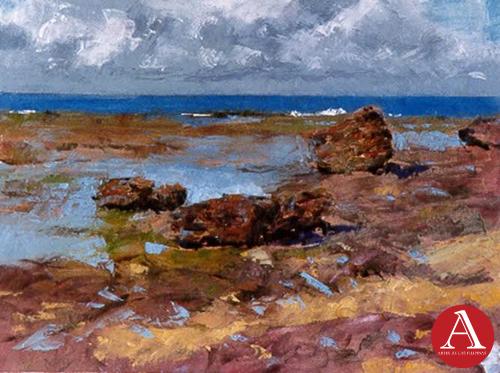
Impending Rain, Sydney, Australia, oil (1994)
Are you represented by any gallery in Sydney?
No. I am not that active painting in Sydney.
When was the last time you exhibited your sculptural figures?
I think it was the show at CCP “Memory is short.”
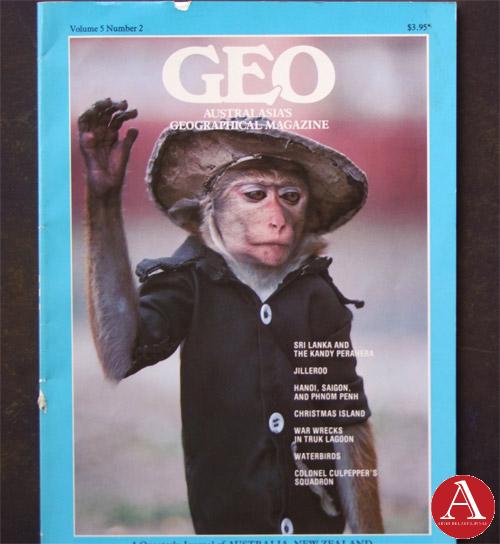
Cover of Geo magazine where Roces served as an editor for twelve years
Cover Photo by Roces
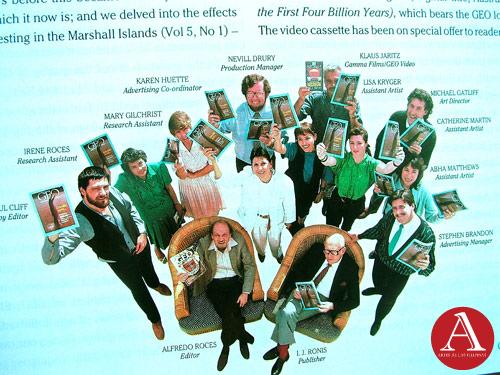
Roces and his staff of Geo Magazine (1989)
Do you still paint today or do you just do pottery?
I have never stopped painting but have become less active exhibiting. I have discontinued my pottery because of lack of facilities such as a kiln, available clay, large open air space for raku, etc. Aside from pottery I also do a lot of photography which I continue to this day. In the 80’s and 90’s I practiced photo journalism professionally for the quarterly magazine here in Australia, called Geo, Australasia’s Geographical Magazine. I was editor of the magazine. I have exhibited my photographs in Singapore, under the auspices of Kodak 1992 and the Australian Centre in Makati in 1992 and at the Oarhouse. I also use photography as an art medium. I also like to work with digital art and use the iPad for art work. My iPad works have been exhibited at the Crucible Gallery. And as you know I also write and continue to do so, My latest book, on FEU’s CEO Dr. Lourdes Montinola was just launched this month at the Far Eastern University.
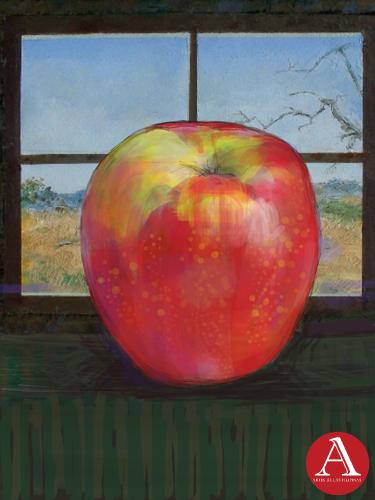
Still Life with Apple (digital art)
How did you get into photography and how do you use this medium in your art practice?
My father was an avid photographer. As a very young boy of eight, I would watch him make prints in the darkroom, actually our bathroom, and it fascinated me to watch the black and white images emerge in the dark. My father gifted me with my first camera. At first it was as photo journalism that I made use of the camera during my travels and research on Philippine fiestas and traditions but I soon saw its possibilities as an art medium in itself. Now with digital photography, I also harness the photograph to manipulate digitally into an art form. So now I use photographs as photo-journalism and documentation, as an art form in itself and as a digital art medium.
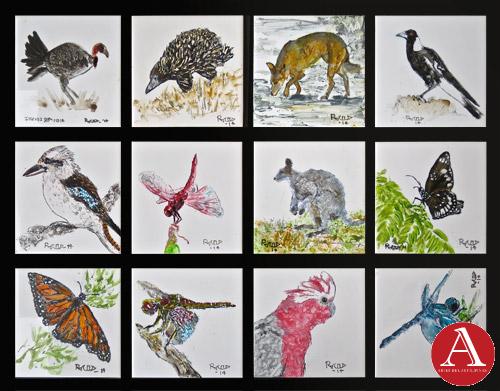
Paintings baked on ceramic (2014)
What is your aim as an artist?
That’s not easy to spell out. It’s a compulsion, I guess. Certainly, self-expression is one strong aim. The challenge of new mediums and themes, ideas, sentiments push me to create. I am confronted by an image or an experience and I am compelled to react and record in words or images, with pen or camera or computer or clay or found objects. I feel joy or rage or pain, and I must purge it out of my system through these mediums of art.
But I also aim to communicate to those who want to engage my work in conversation. Religious images, political commentary (i.e. martial law), beauty of simple things in nature and our everyday urban world (assemblage of junk). There are the subtle qualities and effects of various mediums of art for their own sake. The agonies of sorrow and pain, the celebration of life. I always expect the viewer to contribute his/her thoughts and feelings to complete the work.
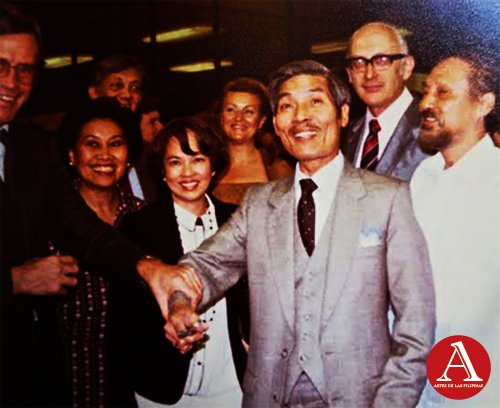
Solo Exhibition at the Philippine Consulate in Sydney, Australia with Con.Gen Nick Valderama
Tell me about you.
I was born in Sta. Cruz, Manila on April 29, 1932. I went through usual schooling. Interrupted by the war. Went back to school at the Ateneo, failed in my second year, transferred to FEU rather than repeat. Then I studied at Notre Dame, Indiana from 1950-54, Art Student’s League from 1956-57. I returned to Manila, taught Humanities at FEU, worked for my father at Roces Hermanos, wrote a daily column for the Manila Times from 1960-72 and painted. I married Irene Pineda in 1958 and have three daughters.
I was also active in research on Filipino arts and traditions. I helped found the Saturday Group where I introduced nude and landscape sketching sessions and the interaction concept. I wrote books on art and was asked to serve as editor of Filipino Heritage. I designed the logo of the CCP. Martial interrupted my career. I moved to Australia where I served as editor of Geo Australasia’s Magazine for twelve years. I am retired now and is focus on writing and painting.

Family Photo taken in Manila with his mother, Inocencia Reyes Roces (late 1970s)
Are you related to Helen Roces Guerrero?
Yes. Her father Ramon Roces is my first cousin so she is actually a niece although older than me.

Portrait of his father done using Ipad from B&W photograph
What are the interests of your father?
My father was an entrepreneur and a highly successful businessman who was engaged in cinema (Ideal Theater), real estate (Roces Hermanos), sports (Manila Jockey Club), education (the Far Eastern University), mining in Buswanga, Palawan, cattle ranching in Malaybalay Mindanao and construction (Santa Clara Lumber & Luxaire Products).
Tell me something interesting about you as a child.
As a child, I watched my father draw and would use his discarded art materials. Being the youngest of nine boys gave me a chance to learn by observing my older brothers successes and failings. But my childhood was also the war. My father would not let us go to school under the Japanese so those still of school age had private tutoring but on the whole learned about life from the streets. I devoured books from my father’s and older brother’s libraries. I learned to entertain and amuse myself while my parents and the family had bigger problems to grapple with. My eldest brother was beheaded by the Japanese. He was awarded the Medal of Freedom by the US government. Four other brothers were with the guerrillas. So I lost my childhood and my innocence during the war and the Liberation years. At the same time, I got a great lesson in life, what with food shortages and fleeing all over the Batangas countryside, living in Taal Volcano and then climbing Tagaytay Ridge to where the American 11th Airborne had landed. Survival occupied our family and of course little me.

(Front row, right, Alejandro, who served as Secretary of Education under President Diosdado Macapagal. Alejandro was named National Artist of Literature. (Back row, third from right, Joaquin who served as Congressman for Manila’s 2nd District for four consecutive terms. Beside him, fourth from right, Jesus who was Vice Mayor of Manila during Lacson’s first term. The other siblings,Luis (front row), Marcos, Francisco and Jose (back row right to left) were all prominent businessmen.
After hiding in Batangas, what happened to you and the rest of your family?
We stayed in Taal Volcano until the American 11th Airborne landed on Tagaytay Ridge. We crossed the lake in a banca and climbed the ridge then with US aid, we managed to get car transport back to Manila.
What was your favorite book as a child?
Aesop’s Fables. There were so many interesting stories with lessons and they were written by a slave from ancient Greece.

Family Photo in Sydney with his mother, Caridad Morente Pineda
(L-R) Mia, Alfredo and Irene; Backrow: Mina and Grace (early 1980s)
What books did you read to your children?
The usual childrens’ fairytales books followed by paperback detective stories.
These days, which do you prefer, e-books or the traditional print?
I am more at home with traditional print.

Culture Shock Philippines, first published in 1985, has gone through several reprints, most recent was in 2013
You also have a huge body of work as a literary artist. How did you get started into writing daily columns and then books?
Three other brothers were writers before me so I guess it runs in our family genes. I have always enjoyed writing. But what pushed me into professional writing was necessity. I became fully aware early on that it was not going to be possible to survive on my paintings so I went into professional writing and teaching humanities. I was writing essays about Philippine art and artists for the pleasure of it but the monograph art books were paying ventures. Doing what I enjoyed and being paid for it to boot was heaven-sent. The early articles attracted the interest of the publishers and editors of the Daily Mirror and I was offered a column.
What was the first book you have written?
The Story of the Philippines published by McCormick-Mathers Publishing Company Inc. 1968, USA. Carlos Romulo suggested my name to the publishers.
What did you do with your first paycheck?
My first paycheck as a columnist was at 20 pesos per column, 600 pesos a month. I handed it to my wife. My first commissioned painting was a still life my father commissioned me to do as he needed a wedding gift for someone and his budget was 45 pesos. I also gave that to my wife. I was supporting a family by then.

Set of Filipino Heritage
What kind of research do you do beforehand to make your writing visceral?
I always do extensive research in libraries and archives plus personal interviews which I often tape and or photograph. I have attended rituals in Palawan and was in the caves of Tabon man with Dr. Fox, I also witnessed the Cultural Revolution in China, attended Pacific festival in Papua New Guinea, etc. My book “Looking For Liling” took at least four years of research to complete.
How would you describe your writing?
Direct, simple, honest.

Published books on artists and Philippine History
You’ve written about Fernando Amorsolo, Anita Magsaysay-Ho, Nonoy Marcelo, SYM Mendoza, to name a few, who among them did you have some difficulty researching and writing?
Every bio-book is different and creates unique problems. Sym Mendoza was the most cooperative and easiest to work with. Ang Kiu Kok was a man of few words so extracting information from him was difficult but he was pleasant and frank.
You work on Felix Resurreccion Hidalgo, who was your source? What other materials did you use to put it all together?
My original sources were conversations with Don Felipe Hidalgo, and Don Alfonso Ongpin, in the early years; Dr. Antonio Molina who provided me data from Spain, Ramon Villegas, Ambeth Ocampo, Luciano Santiago who offered their notes on Hidalgo, along with collectors with Hidalgo paintings. Of course the paintings and drawings are invaluable direct sources of study, and readings on Hidalgo’s contemporaries like Rizal and Luna and their published letters.

Book Cover of Looking for Liling
Do you have a say on the flow and layout of your books?
In some instances I was given full control as layout designer (Amorsolo, Sanso, Hidalgo, Legaspi, Sym,) in others the layout and design were in the hands of the publishers and their sponsors as well as the artists who were the subject (Ang Kiu Kok, Castrillo, Zaballero).

Medals and Shoes by Alfredo and Irene Roces (1992)
What is your time frame when writing an artist’s book?
I require at least a year of research and writing. I usually include this time frame in my contract.

Self Portrait, oil (2009)
They say that a writer’s life bleeds into one’s work. Have you experienced the same?
The subconscious is unavoidable and in painting it is even desirable for me to bleed my life into a painting. In nonfiction writing, I strive to be objective and put myself in the shoes of the subject artist.
Have you experienced repeating yourself/your words in your succeeding writing?
I wrote a column every day for twelve years, I very likely repeated myself in these. But when I write books, I try to avoid these so even when I recount an incident a second or third time, I try to either put in fresh words or simply quote myself and the original source where it appeared.
What is your dream project to write?
I hope to write a trilogy: one on pre-Hispanic Philippines, the other on the Hispanic and the third on the 20th American period to the present. Adios Patria Adorada was the Hispanic. Two volumes to go.
I also hope to write a book about my own life and times with my paintings as illustrations. Part of the dream, of course, is a retrospective show of paintings to go with the book.

Seven Last Words, ink on gold-foil cardboard (1957)
If you were to write a synopsis about your life in one paragraph, what would you write?
He lived through what the Chinese call as interesting times. First as a child in World War II and Japanese occupation experiencing life in rural Batangas while fleeing Japanese soldiers; followed by a five year interlude as a student in the US; then starting a career back in the Philippines only to be confronted by Martial Law and start life all over again in Australia.
Blessed with a lovely wife and three daughters, he does his best to be a good husband and father, a professional who strives to live and express himself as an authentic, creative, God-loving, human being.

Photo painting at Fraser Island
What is something about you that people may be surprised to know?
Very few people are aware that my eyesight hangs by a thread. I lost the central vision of my left eye to macular degeneration more than a decade ago and now my right eye is in the same situation. Fortunately, nowadays, they have injections that can offset but not cure the ailment. I have to get eye injections every six weeks or I lose my vision and be declared legally bind. That is the worst fate for any writer and painter. Everyday is a blessing.

In his home studio
What are you looking forward to in the next five years?
Five years is a long ambitious time frame for octogenarians, but I have various projects either in the works or on my “to-do” list. The book “Adios Patria Adorada” was intended to be part of a trilogy: the 19th (Adios), the 20th (started some chapters but stalled) , and the Prehistoric. Currently I am working on my memoirs–my life and times.Naturally, I hope to manage a retrospective of my paintings, assemblage, photographs and pottery. I continue to paint and work on assemblage in my studio-home. I would also like to do something about my father’s diary when we were in Batangas during the war. Also a collection of drawings/prints by an American soldier during the liberation of Manila. The enemy is time.








